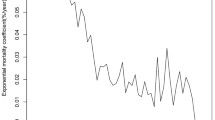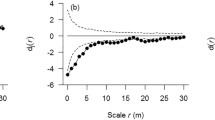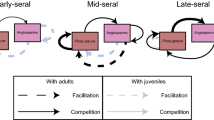Abstract
The null hypothesis that dispersal syndrome is not related to characteristics of forest tree populations was explored using a 4.5 ha mapped plot in a subtropical mixed-species forest in northern Florida, USA. Dispersal syndrome was not related to physiognomy, abundance, or spatial dispersion of tree species. Of the common trees, small individuals of three species that produced the largest-sized propagules, (Carya spp., Quercus michauxii, Q. nigra) were positively associated with localized gaps within the forest. Patterns to the distribution of juveniles of these species suggest that propagules are not differentially dispersed to gaps. In addition, slow growth of these species, even in gaps, precludes growth into the understory stratum prior to gap closure. Instead, juveniles die back and resprout repeatedly prior to entry into the understory in localized gaps. Likelihoods that juveniles will enter the understory are very low and require fortuitous sequential releases from suppression. The dispersal syndrome, in which propagules are distributed over the forest floor at low uniform densities as a result of scatterhoarding by mammals, especially squirrels, appears essential for these species to be co-dominants in this forest.
Access this chapter
Tax calculation will be finalised at checkout
Purchases are for personal use only
Preview
Unable to display preview. Download preview PDF.
Similar content being viewed by others
Literature cited
Augspurger, C.K. 1984a. Light requirements of neotropical tree seedlings: a comparative study of growth and survival. J. Ecol. 72: 777–795.
Augspurger, C.K. 1984b. Seedling survival of tropical tree species: interactions of dispersal distance, light-gaps, and pathogens. Ecology 65: 1705–1712.
Augspurger, C.K. and C.K. Kelly. 1984. Pathogen mortality of tropical tree seedlings: experimental studies of the effects of dispersal distance, seedling density, and light conditions. Oecologia 61: 211–217.
Baker, H.G. 1972. Seed weight in relation to environmental conditions in California. Ecology 53: 997–1010.
Blaisdell, R.S., J. Wooten and R.K. Godfrey. 1974. The role of magnolia and beech in forest processes in the Tallahassee, Florida, Thomasville, Georgia area. Proc. Tall Timbers Fire Ecology Conf. 13: 363–397.
Boucher, D.H. 1981. Seed predation by mammals and forest dominance by Quercm oleoides, a tropical lowland oak. Oecologia (Berl.) 49: 409–414.
Brokaw, N.V.L. 1982. The definition of treefall gap and its effect on measures of forest dynamics. Biotropica 11: 158–160.
Brokaw, N.V.L. 1985. Gap-phase regeneration in a tropical forest. Ecology 66: 682–687.
Clark, P.J. and F.C. Evans. 1955. On some aspects of spatial pattern in biological populations. Science 121: 397–398.
Connell, J.H. 1971. On the role of natural enemies in preventing competitive exclusion in some marine animals and in rain forest trees. In: Dynamics of Populations (eds. P.J. Den Boer and G.R. Gradwell), pp. 298–310, Centre for Agricultural Publishing and Documentation, Wageningen, Netherlands.
Delcourt, H.R. and P.A. Delcourt. 1977. Presettlement magnolia-beech climax of the Gulf Coastal Plain: quantitative evidence from the Apalachicola River Bluffs, north-central Florida. Ecology 58: 1085–1093.
Diggle, P.J. 1975. Robust density estimation using distance methods. Biometrika 62: 39–48.
Donnelly, K. 1978. Simulations to determine the variance and edge-edge effect of total nearest neighbor distance. In: Simulation methods in Archaeology (ed. I. Hodder), pp. 91–95, Cambridge Univer. Press, London.
Forman, R.T.T. and D.C. Hahn. 1980. Spatial patterns of trees in a Caribbean semievergreen forest. Ecology 61: 1267–1274.
Foster, S.A. and C.H. Janson. 1985. The relationship between seed size and establishment conditions in tropical woody plants. Ecology 66: 773–780.
Grime, J.P. and D.W. Jeffrey. 1965. Seedling establishment in vertical gradients of sunlight. J. Ecol. 53: 621–642.
Hallé, F., R.A.A. Oldeman and P.B. Tomlinson. 1978. Tropi cal Trees and Forests. Springer-Verlag, New York.
Hartshorn, G.S. 1980. Neotropical forest dynamics. Biotropica 12(2) Suppl.: 23–30.
Herrera, C.M. 1982. Seasonal variation in the quality of fruits and diffuse competition between plants and avian dispersers. Ecology 63: 773–785.
Herrera, C.M. 1985. Determinants of plant-animal coevolution: the case of mutualistic dispersal of seeds by vertebrates. Oikos 44: 132–141.
Hirsch, D.W. 1981. Physiognomy and spatial patterns of a beech-magnolia hammock in north central Florida. Unpub. Masters thesis, Fl. State Univ.
Howe, H.F. and G.F. Estabrook. 1977. On intraspecific competition for avian dispersers in tropical trees. Am. Nat. 1ll: 817–832.
Howe, H.F., E.W. Schupp and L.C Westley. 1985. Early consequences of seed dispersal for a neotropical tree (Virola surinamemis). Ecology 66: 781–791.
Howe, H.F. and J. Smallwood. 1982. Ecology of seed dispersal. Ann. Rev. Ecol. Syst. 13: 201–228.
Hubbell, S.P. 1979. Tree dispersion, abundance, and diversity in a tropical dry forest. Science 203: 1299–1309.
Hubbell, S.P. and R.B. Foster. 1983. Diversity of canopy trees in a neotropical forest and implications for conservation. In: Tropical Rain Forest: Ecology and Management (eds. S.L. Sutton, T.C Whitmore, A.C. Chadwick), pp. 25–41, Blackwell Scientific Publications, London.
Janson, C.H. 1983. Adaptation of fruit morphology to dispersal agents in a neotropical forest. Science 219: 187–189.
Janzen, D.H. 1970. Herbivores and the number of tree species in tropical forests. Am. Nat. 104: 501–528.
Janzen, D.H. 1977 Seed predation by animals. Ann. Rev. Ecol. Syst. 2: 465–492.
Jensen, T.S. 1985. Seed-seed predator interactions of European beech, Fagus sylvatica and forest rodents, Clethrionomys glareolus and Apodemus flavicolis. Oikos 44: 149–156.
Johnston, R.D. and C.J. Lacey. 1983. Multi-stemmed trees in rainforests. Aust. J. Bot. 31: 189–195.
Keay, R. W. J. 1957. Wind-dispersed species in a Nigerian forest. J. Ecol. 45: 471–478.
Kurz, H. and R.K. Godfrey. 1962. Trees of Northern Florida. Regency Press, Inc., Gainesville, Florida.
Levin, D.A. and H. Kerster. 1969. Density-dependent gene dispersal in Liatris. Am. Nat. 103: 61–74.
Ligon, J.D. 1978. Reproductive interdependence of pinon jays and pinon pines. Ecol. Monogr. 48: 111–126.
Loach, K. 1970. Shade tolerance in tree seedlings. II. Growth analysis of plants under artificial shade. New Phytol. 73: 1215–1219.
McKey, D. 1975. The ecology of coevolved seed dispersal systems. In: Coevolution of Animals and Plants (eds. L.E. Gilbert and P.H. Raven), pp. 159–191. University of Texas Press, Austin, Texas.
Nilsson, S.G. 1985. Ecological and evolutionary interactions between reproduction of beech Fagus sylvatica and seed eating animals. Oikos 44: 157–164.
Opler, P.A., H.G. Baker and G.W. Frankie. 1977. Recovery of tropical lowland forest systems. In: Recovery and Restoration of Damaged Ecosystems (eds. J. Cairns, K.L. Dickson and E.E. Herricks), pp. 379–419, University of Virginia Press, Charlottesville, Virginia.
Opler, P.A., H.G. Baker and G.W. Frankie. 1980. Plant reproductive characteristics during secondary succession in neotropical lowland forest ecosystems. Biotropica 12 (Suppl.): 40–46.
Platt, W.J. 1975. The colonization and formation of equilibrium plant species associations on badger disturbances in a tallgrass prairie. Ecol. Monogr. 45: 285–305.
Platt, W.J. 1976. The natural history of a fugitive prairie plant (Mirabilis hirsuta [Pursh] MacM.). Oecologia 22: 399–409.
Platt, W.J. and I.M. Weis. 1985. An experimental study of competition among fugitive prairie plants. Ecology 66: 708–720.
Rabinowitz, D. and J.K. Rapp. 1981. Dispersal abilities of seven sparse and common grasses from a Missourie prairie. Am. J. Bot. 68: 616–624.
Radford, A.E., H.E. Ahles and C.R. Bell. 1968. Manual of the Vascular Flora of the Carolinas. Univ. N. Carolina Press, Chapel Hill, N. Carolina.
Ridley, H.N. 1930. The Dispersal of Plants throughout the World. Ashford: Reeve.
Ripley, B.D. 1979. Tests of ‘randomness’ for spatial points patterns. J. Royal Statistical Soc. (London), Series B 41:368–374.
Runkle, J.R. 1982. Patterns of disturbance in some old-growth mesic forests of eastern North America. Ecology 63: 1533–1546.
Salisbury, E.J. 1942. The Reproductive Capacity of Plants. Bell, London.
Sinclair, D.F. 1985. On tests of spatial randomness using mean nearest neighbor distance. Ecology 66: 1084–1085.
Silvertown, J,W. 1980. The evolutionary ecology of mast seeding in trees. Biol. J. Linn. Soc. 14: 235–250.
Smith, C.C. 1970. The coevolution of pine squirrels (7am-iasciurus) and conifers. Ecol. Monogr. 40: 349–371.
Smith, C.C. 1975. The coevolution of plants and seed predators. In: Coevolution of Animals and Plants (eds. L.E. Gilbert and P.H. Raven), pp. 53–77, University of Texas press, Austin, Texas.
Smythe, N. 1970. Relationships between fruiting seasons and seed dispersal methods in a neotropical forest. Am. Nat. 104: 25–35.
Sokal, R.R. and F.J. Rohlf. 1969. Biometry. Freeman, San Francisco.
Sork, V.L. and D.H. Boucher. 1977. Dispersal of sweet pignut hickory in a year of low fruit production, and the influence of predation by a curculionid beetle. Oecologia 28: 289–299.
Stapanian, M.A. 1982a. Evolution of fruiting strategies among fleshy fruited plant species of eastern Kansas. Ecology 63: 1422–1431.
Stapanian, M.A. 1982b. A model for fruiting display: seed dispersal by birds for mulberry trees. Ecology 63: 1432–1443.
Stapanian, M.A. and C.C. Smith. 1978. A model for scatterhoarding: coevolution of fox squirrels and black walnuts. Ecology 59: 884–896.
Thorington, R.W., Jr., B. Tannenbaum, A. Tarak and R. Rudran. 1982. Distribution of trees on Barro Colorado Island: a five hectare sample. In: The Ecology of a Tropical Forest: Seasonal and Long-term Changes (eds. E.G. Leigh Jr., A.S. Rand and D.M. Windsor), pp. 83–94, Smithsonian Institution Press, Washington, D.C.
United States Forest Service. 1974. Seeds of Woody Plants in the United States. U.S. Dept. Agri. Hndbk. No. 450. Washington, D.C: USGPO. 883pp.
Werner, P.A. 1976. Ecology of plant populations in successional environments. Syst. Bot. 1: 246–268.
Werner, P.A. and W.J. Platt. 1976. Ecological relationships of co-occurring goldenrods (Solidago: Compositae). Am. Nat. 110: 959–971.
Wheelwright, N.T. 1985. Fruit size, gape width, and the diets of fruiting-eating birds. Ecology 66: 808–818.
Whitmore, T.C. 1978. Gaps in the forest canopy. In: Tropical Trees as Living Systems (eds. P.B. Tomlinson and M.H. Zimmerman), pp. 639–51, Cambridge University Press, Cambridge.
Williamson, G.B. 1975. Pattern and seral composition in an oldgrowth beech-maple forest. Ecology 56: 727–731.
Author information
Authors and Affiliations
Editor information
Rights and permissions
Copyright information
© 1986 Dr W. Junk Publishers, Dordrecht
About this chapter
Cite this chapter
Platt, W.J., Hermann, S.M. (1986). Relationships between dispersal syndrome and characteristics of populations of trees in a mixed-species forest. In: Estrada, A., Fleming, T.H. (eds) Frugivores and seed dispersal. Tasks for vegetation science, vol 15. Springer, Dordrecht. https://doi.org/10.1007/978-94-009-4812-9_27
Download citation
DOI: https://doi.org/10.1007/978-94-009-4812-9_27
Publisher Name: Springer, Dordrecht
Print ISBN: 978-94-010-8633-2
Online ISBN: 978-94-009-4812-9
eBook Packages: Springer Book Archive




